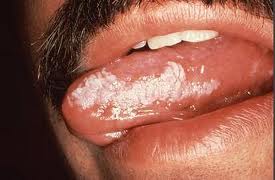What is oral thrush?
Oral thrush, otherwise known as acute pseudomembranous candidioasis, is the infection of mucosal tissues of the mouth by a fungus, mainly candida albicans, but it can also be caused by candida glabrata or candida tropicalis. Candida albican is one of many microorganisms that exists in your mouth, but under certain circumstance they multiply uncontrollably and become an infection. The areas involved are usually the inner sides of the cheek, the tongue, tonsils, palate and floor of the mouth. They vary in size from small drop-like areas to confluent large patches covering a wide area.
What are the causes of oral thrush?
-
Local factors:
-trauma to mucosal tissues
–denture wearing & hygiene, especially if they are not kept clean, are worn throughout the night over a long period of time, or do not fit well(loose)
-tobacco smoking
-carbohydrate rich diet
2. Age:
-extremes of age: infants (seen in 5% of infants) or old age (seen in 10%). In infants it is usually associated with their immature antimicrobial defences, candida being picked up from the birth canal. This can be seen if the mother has vaginal candidal infection, which is caused by the same candida causing oral thrush; the candida can be easily passed on to the newborn child.
3. Drugs:
-Broad-spectrum antibiotics: people who are on antibiotics have a higher risk of developing oral thrush. Antibiotics may destroy the bacteria that prevent the Candida from reproducing out of control.
-excess mouthwash usage: the same principle applies as in antibiotics intake; individuals who overuse antibacterial mouthwashes may destroy bacteria which keep Candida at bay, thus increasing the risk of developing oral thrush.
–steroids
–chemotherapy and drugs that suppresses the immune system
4. Dry mouth (xerostomia)
-xerogenic drugs (drugs that causes dry mouth)
–Sjogren’s syndrome
–Radiotherapy
5. Systemic disease
-Iron deficiency (anemia)
-Pregnancy
-Malabsorption/ malnutrition
-Megaloblastic anemia
-Acute leukemia
-Other malignant disease
–Diabetes mellitus: If you have uncontrolled diabetes, there can be large amounts of sugar in your saliva, which attracts and encourages the growth of candida species
-HIV & AIDS & other immunodeficiency states: patients with decreased immune system are more susceptible to opportunistic organisms such as candida
What are the symptoms of oral thrush?
Oral thrush presents as a thick white coating on the mucosal surface of mouth, which resembles milk curds. They can be scraped away leaving a red, raw and often bleeding surface. In fact this is a characteristic feature of oral thrush that helps the dental practitioner identify the condition easily. It is often associated with cracking and redness at the corners of your mouth (especially in denture wearers). The patient may experience a rapid onset of bad taste or loss of taste, burning sensation of the mouth and throat, prior to emergence of this white lesion. Oral thrush can sometimes spread to the roof of the mouth or the back of the throat, in which case the patient will experience difficulty in swallowing food or liquid. Oral thrush can spread from the mouth to the throat to other parts of the body.
How is oral thrush diagnosed?
Oral thrush can easily be diagnosed through history taking and checking to see whether the patch can be swiped away leaving a red surface. However, sometimes it may be necessary to view the lesion under a microscope. Under a microscope, it will appear as candida species infiltrating the superficial layers of the mucosal surface, accompanied by some inflammatory exudates. Occasionally, blood tests can be carried out to identify the underlying cause of this infection.
What are the treatments for oral thrush?
1. Remove underlying cause if possible, eg if the drug taken causes dry mouth, try to discuss with the patient’s physician to have the drug changed.
2. Antifungals can be given, for example, nystatin tablets or oral suspension, amphotericin (eg fungilin lozenges), and miconazole (dactarin oral gel)
-Patient should also be warned that antifungal medication may cause side effects such as nausea, diarrhea, stomach ache, headache, and indigestion.
3. Chlorhexidine mouthwash should be used for gargling daily, as it has both antibacterial and antifungal effects. Difflam-C mouthwash, which is a benzydamine hydrochloride mouthwash with some antifungal properties can also be used.
4. Denture wearers should keep their dentures clean, i.e.:
-they should not wear their dentures to sleep,
-soak it in diluted hypochlorite solution (bleach), or chlorhexidine mouthwash whenever they’re leaving their dentures out of the mouth, especially before sleep,
-check denture hygiene, ie brushing their dentures with a toothbrush after meals or before sleep
5. Patients can also eat unsweetened yoghurt to reintroduce beneficial bacteria into your mouth.


